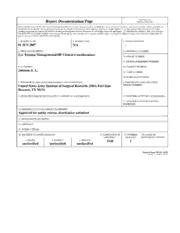
DTIC ADA627939: Eye Trauma Management - OIF Clinical Considerations PDF
Preview DTIC ADA627939: Eye Trauma Management - OIF Clinical Considerations
Report Documentation Page Form Approved OMB No. 0704-0188 Public reporting burden for the collection of information is estimated to average 1 hour per response, including the time for reviewing instructions, searching existing data sources, gathering and maintaining the data needed, and completing and reviewing the collection of information. Send comments regarding this burden estimate or any other aspect of this collection of information, including suggestions for reducing this burden, to Washington Headquarters Services, Directorate for Information Operations and Reports, 1215 Jefferson Davis Highway, Suite 1204, Arlington VA 22202-4302. Respondents should be aware that notwithstanding any other provision of law, no person shall be subject to a penalty for failing to comply with a collection of information if it does not display a currently valid OMB control number. 1. REPORT DATE 2. REPORT TYPE 3. DATES COVERED 01 JUN 2007 N/A - 4. TITLE AND SUBTITLE 5a. CONTRACT NUMBER Eye Trauma ManagementâOIF Clinical Considerations 5b. GRANT NUMBER 5c. PROGRAM ELEMENT NUMBER 6. AUTHOR(S) 5d. PROJECT NUMBER Johnson A. J., 5e. TASK NUMBER 5f. WORK UNIT NUMBER 7. PERFORMING ORGANIZATION NAME(S) AND ADDRESS(ES) 8. PERFORMING ORGANIZATION United States Army Institute of Surgical Research, JBSA Fort Sam REPORT NUMBER Houston, TX 78234 9. SPONSORING/MONITORING AGENCY NAME(S) AND ADDRESS(ES) 10. SPONSOR/MONITOR’S ACRONYM(S) 11. SPONSOR/MONITOR’S REPORT NUMBER(S) 12. DISTRIBUTION/AVAILABILITY STATEMENT Approved for public release, distribution unlimited 13. SUPPLEMENTARY NOTES 14. ABSTRACT 15. SUBJECT TERMS 16. SECURITY CLASSIFICATION OF: 17. LIMITATION OF 18. NUMBER 19a. NAME OF ABSTRACT OF PAGES RESPONSIBLE PERSON a. REPORT b. ABSTRACT c. THIS PAGE SAR 1 unclassified unclassified unclassified Standard Form 298 (Rev. 8-98) Prescribed by ANSI Std Z39-18 TheJournalofTRAUMA(cid:1)Injury,Infection,andCriticalCare Eye Trauma Management—OIF Clinical Considerations LTC Anthony J. Johnson, MD JTrauma.2007;62:S20. D eployed ophthalmologists in combat support hospitals During the first four years of Operation Iraqi Freedom inIraqandAfghanistan,backedbysubspecialtycarein andOperationEnduringFreedom,deployedU.S.Armyoph- military medical centers across the country, are con- thalmologists have treated over 563 combat-related ocular tinuing to provide eye trauma care to deployed troops and injuries,with331rupturedgloberepairs,24primaryenucle- injured civilians via a complex aero-medical evacuation sys- ations, and over 150 eyelid laceration repairs preformed to tem. Whenever possible this involves cooperation with local date. Blast injuries continue to represent the single most resources to provide civilian trauma care and follow-up. In common cause of injury, representing 55% of all ocular contrasttoIraqwhichhadadevelopedmedicalsystembefore injuries, with over 20% of the injuries occurring bilaterally. this conflict, the deployed ophthalmologist in Afghanistan Interestingly, despite high numbers of intraocular foreign representsthehighestlevelofsurgicaleyecareinthecountry bodies there are only 2 reported cases of endophthalmitis in and thus must employ a full range of skills to provide local the database. eye trauma care to injured civilians, in addition to coalition Although in the initial aspects of the conflict the ocular combat wounded. injuries accounted for approximately 14% of all combat in- Thegeneralprinciplesoftraumaeyecareinthemilitary juries, due to a number of factors including stricter enforce- settingarenodifferentfromthoseincivilianmedicalcenters. mentofballisticocularprotection,theocularinjuryratenow Watertight closures are performed on initial presentation as representsapproximately5%ofallcombat-relatedcasualties. thereisnoocularequivalentofthedelayedprimaryclosureor In 89% of the documented injuries in our database the pres- damagecontrolsurgeryfoundinothersurgicaldisciplines.In ence of ballistic eye protection could not be documented. contrast to civilian trauma, the complexity of injuries in war Based on the injury pattern and degree of injury, the vast is much greater in large part due to the effects of blast. majorityofallinjuriesseentodatecouldhavebeenprevented Multiple globe rupture sites and multiple foreign bodies are with the use of ballistic polycarbonate eye protection. notuncommon.AstudybyThachetal.revealedthatinjuries After surgical repair, and upon evacuation out of the that sustained intraocular foreign bodies had an average of theater of operations, many challenges await the injured sol- 1.7 foreign bodies per injury with a range of 1–6. dier.Theyarereassessedandmayundergoadditionalsurgery inGermany,orareevacuatedtotertiarycarefacilitieswhere Copyright©2007byLippincottWilliams&Wilkins,Inc. many undergo multiple additional subspecialty ocular reha- Thisarticlewaswrittenfortheproceedingsfromaconferenceentitled bilitation surgeries. Visual recovery in many instances can 12th Annual San Antonio Trauma Symposium in San Antonio, Texas. The last up to a year or longer. For soldiers who sustain signifi- opinionsorassertionscontainedhereinaretheprivateviewsoftheauthors cantretinatrauma,rehabilitationoptionsarelimited.Current and are not to be construed as official or as reflecting the views of the DepartmentoftheArmyortheDepartmentofDefense. researchintoartificialvisionholdshopeforreturnofvision, BrookeArmyMedicalCenter;email:[email protected]. however, no significant prototypes are expected for at least DOI:10.1097/TA.0b013e3180653eb7 5–10 years. S20 Supplement2007
